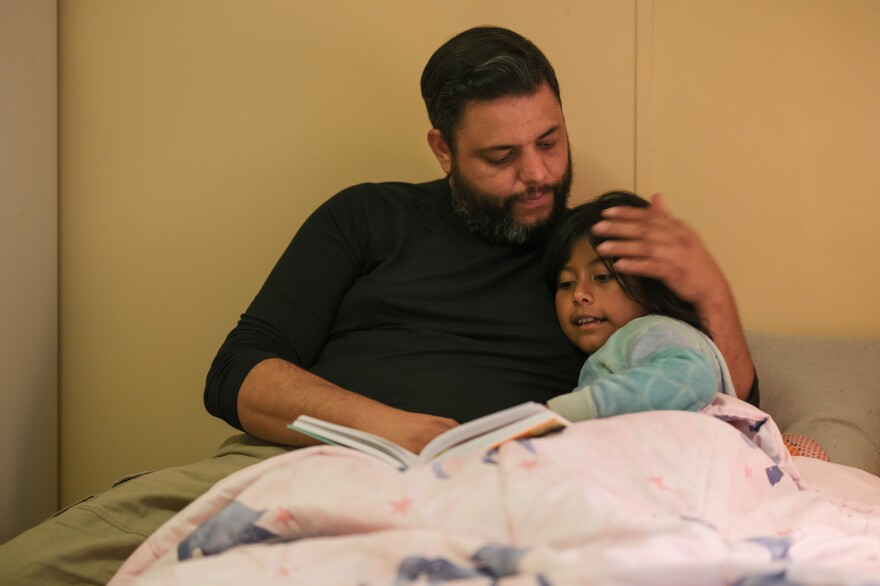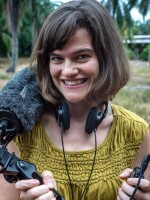When it comes to settling down young children, parenting advice focuses mostly on one tool: What to say.
If the toddler starts to have a tantrum, say this. If a child can't go to sleep, say that. And if you wind up yelling in the process, well, there's even a script for how to apologize.
But all around the world, many parents turn to another tool to soothe a crying child and settle them to slumber. And it's totally silent.
Instead of talking, many parents touch their child. But it's not just any type of touch. Oh no! This touch occurs at a particular speed and with a particular pressure.
After decades of research, neuroscientists are beginning to understand how our skin senses this specific type of touch and how that sensation lights up regions of the brain to alter our emotions.
Turns out, our skin contains nerves especially equipped to detect a gentle, stroking caress. And these nerves are part of a system inside our skin devoted to triggering the warm, calm and peaceful feeling you have when you're with people who love you.
How to give piojito
In Korea, parents call this type of touch yakson. In Taiwan, they say 秀秀(xiù xiù). In India: "we have different languages in different parts of the country, but in Delhi, it's called malish," says Dr. Sarika Chaturvedi, who studies infant massage practices at Dr. D. Y. Patil Vidyapeeth College in Pune. "This type of touch is so ingrained in our culture. It's all about avoiding frustrations in the child and enhancing the pleasurable connection."
But in Latin America, parents may just have the best name of all: Piojitos, which literally means "little lice."
"If I wanted to go to sleep as a child, I would go cuddle with my mom and she would give me piojito," says Joe Grajeda, age 40, who was born in northern Mexico and now lives in Alpine, Texas, with his three young children (Joe owns a coffee shop in Alpine and is a good friend of mine).
"Now I love giving my children piojito," he says, smiling brightly. "My sons like to sit there and just kind of enjoy the moment. Victoria – my daughter – loves it when she's ready to go to sleep."
With piojito and other types of soothing caresses, the key is not to go too fast or too slow. And don't press too deeply. "You scratch someone's back, or their head, with the tip of your fingers. And you do it very lightly and softly," Grajeda explains. "You want to make the skin kind of crawl a little bit." (The late Peruvian linguist Martha Hidlebrandt described piojito as "gently scratching the scalp of a child as if he were being relieved of the itching of imaginary lice" — hence the name.)
In other words, you want to give the child a bit of the goosebumps. "We call it chicken skin in Mexico," he says, chuckling. "I love piojito. I ask my mom now – and my kids – to give me piojito now. I think it's my language of love."

How a gentle caress affects the nerves
When you give a child piojito, the gentle stroking turns on special nerves, in the hairy parts of our skin, called C-tactile fibers. So yes, that includes your head, back and arms.
These nerves are tuned to detect a specific speed of caressing, says Ishmail Abdus-Saboor, a neurobiologist at Columbia University. "If you rush across the skin surface too quickly, a person may actually perceive the touch as aversive," he says.
All mammals have these special neurons. And all mammalian parents use a stroking touch or licking with their young offspring, Abdus-Saboor says. "There's evidence these neurons also respond to maybe even warmth as well," he explains. "So these neurons have the ability to detect social cues between two mammals as they caress, touch and embrace one another, such as a mother with her offspring."
Of course, human parents have been doing this type of touching "forever," Abdus-Saboor says. "This rubbing and stroking is something that we do almost innately with children. And I think it's because our system is wired to tap into this network [in the brain] that provides soothing and relief."
For some kids with autism spectrum disorder, this type of touch might not feel good, Abdus-Saboor notes, and may even feel bad. "A cardinal symptom of autism is hypersensitivity to sensory stimuli, like auditory and tactile stimuli," he says. "The relationship between touch and reward can be greatly altered."
Back in February, Adbus-Saboor and his colleagues published a landmark paper in the journal Cell showing how activation of these special neurons, in mice, lights up the dopamine pathway in their brains. This pathway motivates animals to seek out the touch again – to seek out togetherness, cuddles or grooming.
"These nerves basically have a dedicated, neuronal highway to the brains' reward centers," he says. "So why would you wire a system like this? Well, you know, turning on these neurons is so important for social encounters, relationships, bonding, mating, soothing, calming and stress relief."

In people, activating C-tactile fibers not only feels good, it reduces the perception of pain in adults and babies and lowers their heart beat rate, studies have found. There's evidence that activation of these nerves may also trigger the release of naturally occurring opioids in people's brains, such as endorphins.
"These endorphins relax you and cause you to feel at peace with the world," says psychologist Robin Dunbar at Oxford University. And they help to bond or connect you to the parent who's caressing you. "They make you feel very trusting with the individuals doing the gentle stroking."
Neuroscientist Helena Wasling isn't convinced by the studies linking caressing to endorphins. But she thinks, rather, this type of touch is critical for helping children's feel safe and as if their bodily needs are met.
"Being touched is just a basic need, like having dinner when you are hungry. You need to have this touch in order for you to reach a good, steady state in your body. You need it so you can feel safe enough to go out and explore the world." says Wasling, who has studied the neuroscience of touch for more than a decade and now is a physiotherapist at Sahlgrenska University Hospital in Gothenburg, Sweden.
The dawn of the anti-touch era
During the end of the 19th century, many European pediatricians actually advised parents not to touch their children because they said it would weaken them and make them dependent. This idea hit a fever pitch in the 1920s when the psychologist John B. Watson wrote a parenting book, "even though he knew basically nothing about parenting," Wasling points out. In the book, Watson advises mothers to stay away, physically, from children: "You could give them a pat on the head if they did something really special, but when you greet them in the morning, you could give them a handshake."
Watson thought that lovingly caressing children – as parents all over the world have done for thousands of years – would prevent them from becoming independent, self-sufficient adults. By touching, parents would be "building up a human being totally unable to cope with the world it must later live in," Watson wrote in the book Psychological Care of Infant and Child, published in 1928.
Watson believed that by not touching young children and toddlers, parents teach them to be independent at an early age, Wasling explains.
"But then it turns out that the opposite is actually true," Wasling says. "Children who get a lot of touch, support and closeness from their parents are actually the ones that dare to go out and explore, as they grow up, because they have a basic safety that they can rely on. They have a solid foundation."
It works on grown-ups too
And of course, piojito and all types of gentle caresses can soothe and relax adults, just as much as they do children, says psychologist Robin Dunbar at Oxford University.
"We receive this type of touch when we're sitting in the chair at the hairdressers. And people come out of the hairdressers humming and feeling like they're on top of the world because of their new hair setting," he says, laughing. "But I tell them cheekily, 'It's not your new hair setting that makes you feel that way. It's the endorphins released in your brain while your hairdresser massaged your scalp for an hour.' "
Michaeleen Doucleff, Ph.D. in chemistry, is the author of the book Hunt, Gather, Parent: What Ancient Cultures Can Teach Us About the Lost Art of Raising Happy, Helpful Little Humans
Copyright 2023 NPR. To see more, visit https://www.npr.org.




